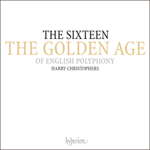
Welcome to Hyperion Records, a British classical label devoted to presenting high-quality recordings of music of all styles and from all periods from the twelfth century to the twenty-first.
Hyperion offers both CDs, and downloads in a number of formats. The site is also available in several languages.
Please use the dropdown buttons to set your preferred options, or use the checkbox to accept the defaults.

So far as we know, Taverner’s is the only sixteenth-century setting of this text, and the style and texture of the music, as well as its formal complexity, place it firmly in the medieval tradition, and suggest that it may be among Taverner’s earlier works, perhaps written while he was still at Tattershall. Polyphonic and structural intricacies do not, however, diminish the inherent qualities of Taverner’s graceful melodic lines and varied sonorities.
from notes by John Heighway © 2000
Taverner a composé tous les vers en polyphonie de sorte que chacune des quatre mélodies de plain-chant reçoive deux différents traitements, ce qui donne une sorte de chaine de variations. En même temps qu’il varie l’arrangement, Taverner varie aussi la présentation du plain-chant lui-même dans chaque vers. Par exemple, dans le premier vers la mélodie apparait, de façon un peu compliquée, dans la seconde voix en descendant (la moyenne), tandis que dans le vers suivant, la même mélodie est exprimée en canon entre les voix moyenne et ténor.
A notre connaissance, la mise en musique de ce texte par Taverner est la seule qui fut composée au seizième siècle et le style et la texture de la musique, aussi bien que sa complexité de forme, la situe fermement dans la tradition médiévale, et suggère qu’elle peut faire partie des premières œuvres de Taverner et fut peut-être écrite quand il était encore à Tattershall. Les complexités de structure et de polyphonie ne diminuent, pourtant, en rien les qualités inhérentes aux lignes mélodiques gracieuses et aux sonorités variées de Taverner.
extrait des notes rédigées par John Heighway © 2000
Français: Hypérion
Soweit uns bekannt, ist die von Taverner die einzige Vertonung dieses Textes aus dem 16. Jahrhundert. Stil und Struktur der Musik sowie ihre formale Komplexität reihen sie zweifelsfrei ein in die mittelalterliche Tradition und deuten darauf hin, dass sie zu Taverners Frühwerken zählt und bereits während seines Aufenthalts in Tattershall entstanden sein könnte. Dergleichen polyphone und strukturelle Feinheiten beeinträchtigen jedoch nicht die Qualität von Taverners anmutiger Melodieführung und vielfältiger Klanggestaltung.
aus dem Begleittext von John Heighway © 2000
Deutsch: Anne Steeb/Bernd Müller
 The Sixteen & The Golden Age of English Polyphony The Sixteen & The Golden Age of English PolyphonyWhen The Sixteen embarked upon their recording career back in 1982, few would have been able to predict quite how far they would go towards rehabilitating the little-known music of these four master composers of the 16th century. In this their 30t ...» More |

